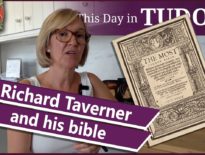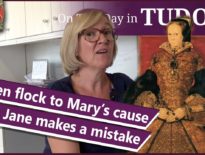On this day in Tudor history, 13th July 1553, while John Dudley, Duke of Northumberland, was preparing to leave London to apprehend the late Henry VIII’s daughter, Mary, members of the new Queen Jane's council were meeting with the imperial ambassadors.
What was the meeting about? What was the news from East Anglia? And why were councillors beginning to feel uneasy?
Find out what was going on in today's talk.
Also on this day in Tudor history, 13th July 1626, Tudor poet and courtier, Robert Sidney, 1st Earl of Leicester, brother of Sir Philip Sidney, died at Penshurst Place, the family seat in Kent. Sir Philip Sidney is known as one of the great poet and scholars of the Tudor age, but his brother, Robert, was also a talented poet. Find out more, including how historians discovered his work, in last year’s video:
Also on this day in history:
- 1527 - John Dee, astrologer, mathematician, alchemist, antiquary, spy, philosopher, geographer and adviser to Elizabeth I and various influential statesmen during her reign, was born in London.
- 1551 – Death of Sir John Wallop, soldier and diplomat, at Guînes from sweating sickness. His body was buried at Guînes, but then moved to the parish church at Farleigh Wallop, his home town.
- 1566 – Death of Sir Thomas Hoby, diplomat, courtier and translator, at Paris. He was buried in Bisham parish church. His translations included “The Gratulation of M. Martin Bucer unto the Church of England” (1549) and Castiglione's “Il cortegiano” (1561).
- 1612 – Death of Edward Seymour, Viscount Beauchamp, eldest son of Edward Seymour, 1st Earl of Hertford, and Lady Katherine Grey, at Wick in Wiltshire. He was buried first at Bedwyn Magna and then in Salisbury Cathedral.
Transcript:
On this day in Tudor history, 13 July 1553, during the short reign of Queen Jane, also known as Lady Jane Grey, while the queen’s father-in-law, the Duke of Northumberland, was preparing to leave London with the Marquess of Northampton, Earl of Huntingdon and troops to apprehend the late Henry VIII’s daughter, Mary, members of the council were meeting with the imperial ambassadors.
Who were they and what was going on?
Let me tell you…
According to the four imperial ambassadors in England at that time, in a dispatch sent to the emperor, John Russell, Earl of Bedford and Lord Privy Seal, the Earls of Arundel, Shrewsbury and Pembroke, Lord Cobham, Sir John Mason and Sir William Petre requested an audience with the ambassadors. One of the aims of the meeting was, according to the ambassadors, “to ensure the Lady Mary’s safety” following a meeting the previous day with Cobham and Mason in which the English councillors had informed the ambassadors that Jane was queen and that Mary was opposing it. The councillors had gone on to say that the new queen’s council did not want the ambassadors “to assist the Lady Mary or communicate with her to give her advice and support”, and informed that Mary was going to be brought to London, “not to offer any violence to her person if she gave them no reason to do so, but only to restore peace and order where they had been troubled.” The councillors allegedly threatened the ambassadors with “barbarous laws” if they acted in any way to cause suspicion.
The meeting between the councillors and the ambassadors on 13th July seems to have gone well, with the ambassadors recording that “Unless their countenances belied them, the Council were pleased with our discourse, because of the statement of your Majesty's affection for England; and they answered that they intended to reciprocate and act as good neighbours should”.
It is not known whether it was the meetings with the ambassadors or news that Mary was successfully rallying support in East Anglia, or a combination of factors, which made some members of the council start to have second thoughts about their support for Queen Jane, but by 13th July 1553, councillors including William Herbert, Earl of Pembroke, and Henry Fitzalan, Earl of Arundel, were beginning to worry and began considering changing sides. And, the Duke of Northumberland, the previous leader of the government and a strong leader, was not there to dispel their worries and to unite the council. Oh dear! Jane really should have let her father go after Mary.



Leave a Reply